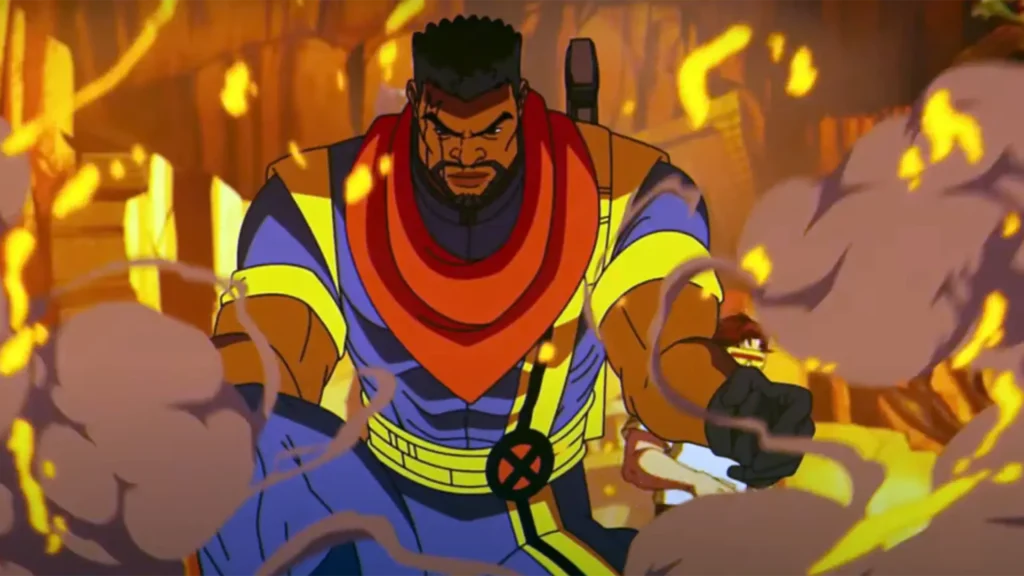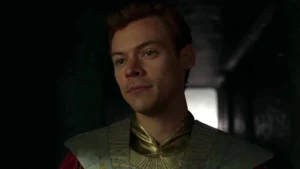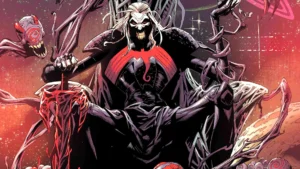Bishop was created by Whilce Portacio and John Byrne and first appeared in The Uncanny X-Men #282 in 1991. Bishop’s full name is Lucas Bishop. Much like Cable, he’s a mutant from the future—the 22nd century, to be exact. He eventually traveled to the past and joined the X-Men, even becoming part of offshoot teams like The Uncanny X-Force. Bishop also has the distinction of being the first black male member of the X-Men. But where did his journey begin? What is his origin?
Although Bishop first appeared in Uncanny X-Men #282, his detailed origin wasn’t revealed until five years later, in 1996, in Xavier Security Enforcers issue #2. This was later expanded upon in the X-Men: The Times and Life of Lucas Bishop 3-issue miniseries. Let’s start with Xavier Security Enforcers issue #2.
At the beginning of issue #2, we see a young Bishop and his sister being attacked by a horde of Emplate mutant vampires that feed on the bone marrow of other mutants. They have just killed the adults leading this class of XSE cadets and start to go after the children. Bishop and the other cadets realize they’re in over their heads. So, right out of the gate, we find out that a young Bishop is a cadet, along with his sister, for the XSE—Xavier Security Enforcers. This group of mutants is trying to carry on Charles Xavier’s and the X-Men’s legacy in the future.

We see one of these Emplates holding Bishop’s sister, Shard, in the air as she yells, “Bishop!” The Emplate asks, “And who is Bishop, little morsel? Father? Brother? Deity? It doesn’t matter; no one could help you now, and you’re too young to help yourself.” As his sister screams, “Bishop, it hurts, stop hurting me,” a caption says, “A mutant’s special talent generally emerges with the onset of puberty, triggered by stress. Shard’s under a lot of stress, so her talent manifests a little early,” as we see her release pink energy everywhere. Another caption says, “Fortunately for her brother, his talent is to absorb, amplify, and redirect energy. This keeps him from being fried alive.” Now that Bishop has absorbed the energy from his sister, he fires it at the Emplate, saying, “Everybody, back into a tight circle, back to back. That only bought us a second or two. We’ve got to group together if we’re going to survive, and I used up my charge.” Shirley asked, “Bishop, what do we do? We can’t hold them off by ourselves.” Bishop, being the leader personality that he is, says, “We use what we’ve got. Shirley, you’re the best shot on the practice field. Catch,” as he throws her a gun. The cadets do their best to try to hold them off, but soon they become overwhelmed. Bishop says, “Make every shot count; we need more time until help gets here.” His fellow cadet says, “But what if they don’t come?” But on the next page, we see they do.
A caption then tells us, “The fallen were their comrades, and the children are their cadets. Most of all, this is the reason the Xavier Security Enforcers, the XSE, were formed. Many had fought in the Summers Rebellion when humans and mutants alike joined together to overthrow the hated Sentinels that held everything in check. When after the rebellion was won, tensions between humans and mutants threatened the hard-won peace, so the XSE was formed. This is an organization whose mission is to keep alive the dream of Professor Charles Xavier, the dream of a world where humans and mutants could live together in peaceful coexistence. To that end, they have pledged their very lives.” The battle is brief, intense, and final as help arrives. One of the adult XSE officers says, “Bishop, you did good. You saved the kids in your class.” One month later, a special ceremony is held, honoring the dead and the living. The presenter says, “We commend the work of Shirley Baylor and Shard, but it is you, Bishop, that the primary credit goes to for rescuing your classmates. Today, you become the youngest cadet ever to be invested as an officer in the XSE. This is not a reward, however. The deaths of our beloved comrades, Shot and Trace, underscore the need for competent officers in the field. Your knowledge of the street is sorely needed there. Take then the shield of office. It is the symbol of the legendary X-Men, of the dream they incarnated, the promise of what may be. Wear it with honor or not at all.” From here, Bishop would become one of the best members of the XSE, eventually traveling back to the past, where he would meet and join the X-Men. But more on that later.
Years later, in 2009, we would get X-Men: The Times and Life of Lucas Bishop, a three-issue miniseries. It expanded his origin and changed it up a little bit, but for the most part, it fleshed out Bishop’s life before he became a cadet for the XSE. In issue #1 of the series, we see Burnham Bishop, Bishop’s dad, come running in, waking up his wife, saying, “We have to go. If I explain, it will be too late. Please, Katie.” We find out he’s in such a hurry to get them out of there because he’s picked up on chatter on a high-level security band that in less than 90 minutes, there’s going to be a tactical nuclear explosion right where they’re standing. Captions from Bishop then say, “Burnham and Katie Bishop made it out on the last flight before the first missile. They were my parents. My life from the very beginning has been ruled by luck and horror. Yeah, I’m lucky to be alive, but I was born into a world of horror.” Thirty-seven hours later, Bishop’s parents end up at an immigrant processing center, with the caption saying, “My parents tried to keep a low profile, but by this time, America has a firm ‘no mutants welcome’ policy.” At the immigration processing center, they’re detected by Sentinels and are immediately captured and put on trial, which lasted 3 seconds. They were sent to a mutant internment camp in Sheep Bay, notorious for being unsanitary, overcrowded, and a place for illegal experimentation on mutants.
Bishop continues narrating, saying, “I would come to know it as something else: home.” Seven months later, his mother would give birth to Bishop at the camp. Bishop then continues narrating as we see his birth, with him saying, “Most people don’t remember anything before the age of 2 or 3. Maybe I’m imagining it, but I swear I have memories from the second after I was born. I remember fighting. My parents fought too. They were supposedly happy once, but I never saw any evidence of that. My mother spent much of her time away from us with other mutants in the camp. Apparently, she could put up a mental force field as well as a physical one. My father mostly cared for me. He didn’t say much, but he used to hold me close to him. I remember the tight muscles of his chest, the way he smelled, how safe it felt in his arms.” By the time I turned three, we had two new members of the family: my little sister, Shard, and my grandmother, who I’d never met. She had been in another camp and heard about us being here. She’d worked out a transfer. I was too young to ask how. Long story short, they would eventually start doing experiments on mutants at this camp, including Bishop’s mother, destroying the right side of her face. Eventually, it was Bishop’s turn, and they branded the right side of his face, etching an M over his eye. If you ever wondered how he got that scar on his right eye, that’s how. They branded it on him to let everyone know that he was a mutant. Soon after this, the Summers Rebellion would happen, where mutants would fight back. During the fight, Bishop’s father would be killed and turned to dust. Bishop was able to escape, making his way to Manhattan, eventually meeting someone called the Witness, or LeBeau, who some people believe is an older version of Gambit. But ultimately, Bishop would reunite with his grandmother, and when he was older, he would become a cadet for the XSE. This brings his origin full circle with his previous one. There are several changes here and there, but overall, they tell the same story, with the latter fleshing it out more.
Now it’s time to move on to story arcs and publication history. The first time we saw Bishop was in Uncanny X-Men issue #282. It’s the very first story where we see him make his appearance on the last page of the issue, coming after a mutant villain from his timeline named Fitzroy. Fitzroy is a mutant with the ability to absorb a person’s life force and create time and space portals. He travels to the X-Men timeline to join the Upstarts, seeking to be their new leader, fighting against Shinobi Shaw. We find out Fitzroy is a real problem as he puts Emma Frost into a coma and kills a bunch of Hellions. The Hellions were originally created by Emma Frost, aka The White Queen, to fight the New Mutants. Now, with Fitzroy screwing up things in the present, going after the X-Men and all that, it causes Bishop and the XSE, who are all from the same timeline as Fitzroy, to travel from the future to the present to stop Fitzroy. As we see Bishop arrive on the last page of issue #282, holding up Fitzroy by the neck, essentially, this is a story that ultimately leads to Bishop becoming a member of the X-Men. So, chasing down the villain Fitzroy brings him to the X-Men timeline. By the time issue #287 rolls around, Bishop is healing up from the wounds after the whole Fitzroy debacle. Xavier tells the X-Men he’d like to be alone with Bishop. As the X-Men walk outside, after a while, Xavier walks out of the room with Bishop, saying, “Let us all hope your confidence in me is well-founded because, my students, I’m proud to formally introduce you to Bishop, the newest X-Men.” As Iceman, Jean, Storm, Colossus, and Archangel look on in shock.
Another major storyline, besides Bishop’s first one, is the Onslaught Saga, specifically Onslaught X-Men. For those of you unfamiliar with Onslaught, he is the result of fractured pieces of Xavier and Magneto merging to create an entirely new entity. We actually broke down everything you need to know about Onslaught in this episode right here, so make sure to check out that episode as well. In any case, in Onslaught X-Men, at the end of the issue, Onslaught says, “Because of your failure, Bishop, everyone dies,” as captions read, “100 years from this moment, the X-Men will have been murdered, betrayed by one of their own. That’s what would have happened if not for the determination of one man, a man who in an instant, in a single act of self-sacrifice, throws himself between the forces of destiny and reality.” As we see Bishop put himself between the mutant race and Onslaught’s death beam, Bishop is able to use his energy-absorbing ability to absorb the entirety of Onslaught’s attack. Onslaught says, “Impossible! That was enough psionic energy to stop a thousand mutants, yet you live!” Bishop responds, “As Jean said, the dream never dies,” as he collapses from taking the full blast of Onslaught. But this single moment alone is one of the most important moments in all of X-Men history, and certainly in Bishop’s, as he put himself in the middle of absorbing Onslaught’s energy blast. As the comic says, all of the X-Men would have been murdered, but Bishop single-handedly stopped that with his bravery and unique powers.
Another impactful story for Bishop is the Messiah Complex storyline. This is one of the most impactful stories for Bishop because it centers around him trying to stop his future from happening. Bishop believes that Hope Summers is the reason for his horrible timeline, where mutants are forced into camps and incarcerated. He believes she will one day grow up to destroy millions of humans and justify the incarceration of all mutants. In the Messiah Complex storyline, we see Bishop doing what he must to protect his future from happening, and that’s him hunting a young Hope Summers, who’s being protected by Cable. It’s kind of awesome seeing two time-traveling mutants, Cable and Bishop, on opposing sides, and it makes for a very compelling story. This also rolls into the Messiah War storyline. They both go hand in hand. Then, in Cable issue #24 from 2008, we see Bishop chasing down Cable and Hope in epic fashion. He’s almost able to kill Hope, but Cable stops him, with Hope getting the upper hand on Bishop before Cable eventually sends Bishop to a post-apocalyptic New York City in 6700 AD. This causes Bishop to ask himself if what he’s been doing has been right all along. By the time Children of the Atom issues #1 through #4 roll around, Bishop would find redemption for trying to kill Hope during Messiah Complex. He found redemption by teaming up with Cable. In the 2023 Hellfire Gala, most mutants were killed or transported off-planet, only leaving a few on Earth. This directly led into the Fall of X event. But with most mutants gone and Krakoa no more, the Children of the Vault decided to conquer the world. Bishop and Cable decide to team up and try to stop them. This was a huge deal because, again, Bishop had been hunting and trying to kill Hope, Cable’s daughter, for a long time. But teaming up with Cable gives him redemption as he was clearly running around as a villain trying to kill Hope for a long time. There are many more Bishop story arcs we could talk about, but these are some of his most prominent moments. Don’t worry, we’ll give you more reading recommendations.
Now it’s time for powers and abilities. Bishop’s main mutant ability is energy absorption and redirection. This means Bishop can absorb energy from any source, literally. Energy from power plants, blasts from villains, anything. He can absorb it and then use it to increase his physical abilities or strength or even redirect it outward, using it as concussive blasts. He could also channel this energy through weapons, most notably his giant gun. We’ve seen him use this ability countless times, like absorbing a bunch of volts enough to maintain an entire city, only to unleash it on Juggernaut, taking him down, as seen in Uncanny X-Men issue #322. And like I said earlier, this ability is so powerful, he was able to absorb the full blast from Onslaught, one that Onslaught said was capable of killing 1,000 mutants. That is just insane! Bishop is very overlooked, in my opinion. This dude is dangerous, and not a lot of comic fans realize it. I mean, just think about it. Anyone with any sort of energy attack or energy-based power can’t do anything to Bishop. He’ll just absorb that crap and throw it right back or make himself stronger. But speaking of energy absorption and redirection, he also has energy conversion, meaning he can convert one form of energy to another form of energy. He also possesses instinctual knowledge, specifically knowing what place and time he’s in at any given moment. He also has superhuman strength, stamina, endurance, speed, and healing, not to mention he has a high degree of durability. Bishop, on top of all that, is a skilled fighter in armed and unarmed combat. All in all, Bishop is a character I hope we see a lot more of in X-Men ’97 Season 2, as we only saw him briefly in Season 1, but he definitely needs some more spotlight because he’s a badass mutant.
For our reading recommendations, you definitely want to start with his first appearance in Uncanny X-Men issue #282, then move to his X-Men: The Times and Life of Lucas Bishop miniseries, the Messiah Complex story, the Messiah War, Extreme X-Men #1 from 2001, Onslaught X-Men issue #1 from 1996, and a little Hope from X-Men #206 and #207. That should be enough to get you started.






